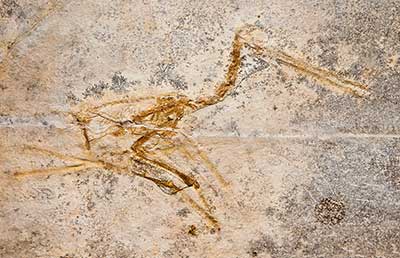| Quick Facts | |
|---|---|
| Name Meaning: | Winged Finger |
| Distribution: | Europe, Africa |
| Time Period: | Late Jurassic, 150 Ma |
| Wing Span: | 5 ft. |
| Diet: | Carnivore |
| Linnaean Classification | |
| Kingdom: | Animalia |
| Phylum: | Chordata |
| Class: | Reptilia |
| Order: | Pterosauria |
| Suborder: | Pterodactyloidea |
| Family: | Pterodactylidae |
| Genus: | Pterodactylus |

History
The Pterodactylus was the first animal to be classified as a flying reptile and the first of the order "Pterosaur." It was described by Cosimo Alessandro from Italy in 1784 from a skeleton discovered in Bavaria. At the time it was not identified as a flying animal. Its discovery was prior to the time when knowledge of dinosaurs became prevalent in the early 1800s. At first, it was thought to be an aquatic animal using the wings as flippers. Johann Hermann proposed, in 1800, that it was a winged animal. He noted the similarities with skin membranes in bats. It wasn't until 1860 that the Pterodactylus was generally concluded to be a winged reptile. Till now, it is a common reptile fossil with over 27 specimens.
Description
The Pterodactylus was relatively small with a wingspan of about 5 ft. It's skull was long and narrow. Its jaw was straight, which was unusual compared to other Pterosaurs, and contained nearly 100 teeth. The teeth were pointed and were longest near the tip of the jaw. A large crest, curved backward, adorned its head and was made of soft tissue. Its long wings did not have the small furry fibers covering the wings of other Pterosaurs. The wings were made of a skin and muscle membrane that stretched from the fourth finger to its legs. Wing membrane was also found between the legs and tail. This is consistent with other Pterosaurs as well as modern day bats.
Lifestyle
The Pterodactylus was a carnivore and most likely preyed on fish and small animals. There is a high degree of variance between juveniles and adults, leading to specimens of Pterodactylus often being mistaken for other species. In a juvenile the teeth were few, approximately 15, and as the Pterosaur would grow the teeth would increase to about 90. The crests are also found primarily on adults only, suggesting it was used in a mating display, and was only needed when the Pterodactylus grew to maturity. It bred seasonally, which accounts for the different age groups found together. Its breeding habits suggest it bred much like crocodilians and less like birds. This is ironic, considering the close relation between birds and dinosaurs.